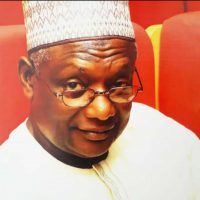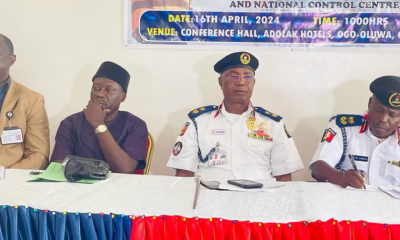Comments and Issues
Use the borrowed $800m for solar rural electrification
Published
11 months agoon

The borrowed $800m earmarked for fuel subsidy removal palliative to benefit 50m vulnerable Nigerians is better invested in providing solar rural mini grid distributed electrification that can bring over 774MW of off-grid electricity to millions of underserved and unserved rural populace. It will also have spillover effects on urban settlements, industries and businesses presently lacking adequate electricity supply from the national grid. The investment can also generate thousands of jobs for millions of jobless Nigerian youths. It will also drastically reduce Nigeria’s carbon foot prints and accelerates Nigeria’s energy transition plan (NETP) and Net Zero Emissions target of 2060 among other benefits.
It is no longer news that Nigeria approached the World Bank for a loan of $800m to use to provide palliative measures or relief measures towards cushioning the harsh or painful effects of removal of existing subsidy from the consumption of Petrol (Premium Motor Spirit – PMS) scheduled for June 2023. Since it became public knowledge that this is what the outgoing administration of President Muhammadu Buhari (PMB) planned to execute before its exit on May 29th, 2023, the issue attracted numerous commentaries from public affairs analysts and other concerned individuals, key stakeholders in the nation’s energy sector including corporate and civil society organizations. The views and opinions expressed by these special interest groups are readily available in the traditional and social media outlets.
It is against this backdrop that there is the need for different approach to this issue by offering a better and more rational alternative to using the loan to provide 50m vulnerable Nigerians with packages of palliative measures that provide just a temporary relief from the withdrawal of subsidy from petrol consumption. Petrol is consumed largely by the rich and privileged private vehicle owners and those who travel by private commercial vehicles, tricycles and motorbikes. This is in addition to those who operate petrol-powered generators for small and medium enterprises (SMEs) and provide electricity for residential houses in the absence of electricity from the national grid.
Hence, it is a better alternative that the borrowed $800m be earmarked for the provision of 1MW each of solar photovoltaic (Solar PV) electricity to all the 774 Local Government Areas (LGAs) (i.e. 774MW). This can be the gamechanger in the Nigerian Electricity Supply Industry (NESI), the Nigerian economy as a whole and Nigeria’s quest for universal access to electricity for all by the year 2030; especially closing the gaps of underserved and unserved segments of the Nigerian population.
Electricity or the power sector is always the leading problematic area in the minds of millions of Nigerians and corporate business entities doing and or wanting to do business in Nigeria. For instance, according to the Power Sector Recovery Plan (PSRP) document, the Nigerian economy is losing about $29.3 billion (over N10.1 trillion) annually which is equivalent to about two percent of GDP. This is largely due to the lack of adequate power. Furthermore, according to a recent document released by the Abu Dhabi based International Renewable Energy Agency (IRENA), Nigeria will require around USD 34.5 billion in total investment to provide electricity access to all households by 2030.
Across Africa and Asia, roughly over 770 million people lack access to electricity according to some recent statistics by the World Bank. Nigeria is among the developing nations with huge chunk of the population (60 per cent) lacking access to electricity. For instance, as already pointed out above, Nigeria’s on-grid power sector is a total mess at the moment and needs very urgent redemption via alternative off-grid mini grid solar-powered distributed arrangements; under Nigeria’s Vision 30:30:30 which aims to achieve 30,000MW of electricity by the year 2030, with 30 percent of the energy mix coming from renewable energy. Access to finance is critical in meeting these electrification targets. This is where this proposition becomes the best short cut alternative to fixing the malaise in the NESI.
Nigeria, with 774 Local Government Councils or Areas which are the third layer or tier of Government as provided for in the 1999 Nigerian Constitution (as amended) has over 60 to 70 per cent of Nigerians living in the rural and peri-urban settlements. These settlements and populace are underserved and or largely unserved (over 85 million Nigerians don’t have access to electricity or less than 41 per cent of rural areas have access to electricity) at all from the national grid network of the NESI. Therefore, investing the $800m or more in providing 1MW Solar power in each of the 774 LGAs, the nation can within six (6) months provide additional 774MW into the NESI from off-grid mini grid solar power generation lasting for up to 25 years of electricity supply round the clock and every day of the week.
Furthermore, working jointly together with the Nigeria Sovereign Authority (NSIA), the Rural Electrification Agency (REA) of the Federal Ministry of Power and the Central Bank of Nigeria (CBN) intervention funds, this can be upscaled up to 2MW or more per LGA to generate up to 1,548MW or more. Given the fact that NSIA, the flagship sovereign wealth fund of the Nigerian Government, announced it will invest $1 billion in solar energy and healthcare over the next three years, both NSIA and REA can jointly work together towards achieving same goals and aspirations for the Sustainable Development Goals aimed at universal access to electricity in Nigeria by the year 2030. For instance, already, NSIA has built and commissioned its first grid connected 10MW solar power plant in Kano state in 2022. Also, the NSIA provided a N10 billion intervention under the Federal Government’s Solar Power Naija programme aimed at seeing solar off-grid connections moving towards new peaks.

Abubakar Atiku Nuhu-Koko
Similarly, the CBN and REA are equally collaborating in rural electrification investment interventions across the country. For instance, to complement the Economic Sustainability Plan (ESP), the CBN launched a N140 billion facility aiming to provide five million solar home systems (SHSs) in under-served and off-grid communities across the country. According to the CBN, the solar connection scheme aims to expand energy access to 25 million individuals (five million new connections) through the provision of solar home systems or connection to a mini-grid. With the plan, the CBN would make funds available to the private companies in the renewable energy sector (green energy). This scheme is being coordinated by the REA, its Rural Electrification Fund (REF) and the office of the Vice President of Nigeria under the “Solar Power Naija’ programme.
Hence, once these lofty programmes are consolidated together and with the infusion of the $800m loan from the World Bank and other contributions from the development partners, additional electricity generation (off-grid) capacity will be added to the existing capacity that is far below what the nation desires. The generated off-grid solar power capacity will be more beneficial to the populace and the national economy than the planned palliative measures targeting just 50m Nigerians.
Therefore, given the fact that Nigeria is abundantly blessed with annual daily sunshine that averages 6.25 hours, it means that harvesting energy from the sun in Nigeria provides boundless opportunities to make meaningful investment in renewable energy supply. It is an investment once made, can last for up to 25 years without major injection of fresh capital beside small maintenance of the facilities from time to time. It will ensure that power needs are met by renewable energy rather than fossil fuels, coal and firewood/charcoal – the most polluting forms of fuels on earth and leading to poor outcomes such as very poor air quality, health and climate change.
Globally and locally, there are excellent testimonies as to the efficacy of solar mini grid rural electrification schemes especially in developing countries. Locally here in Nigeria, the Federal Ministry of Power not long ago commissioned two demonstration rural solar mini grid electrification projects at Torankawa in Yabo Local Government Area and another one at Kurdula in Gudu Local Government Area all in Sokoto State with the support of the European Union, German Federal Ministry of Economic Cooperation and Development(BMZ) under the supervision of Deutsche Gesellschaft fur Internationale Zusammenarbeit (GIZ) GmbH under the Nigerian Energy Support Programme (NESP) Phase I and II. Elsewhere in Africa, for example, Kenya has succeeded in ramping its electricity access from 32 per cent in 2013 to 75 per cent in 2022 using solar power and 86 per cent of the Kenyan economy is now powered by renewable energy (solar and wind energy) – Dr. Akinwumi Adesina, May 27, 2023.
Thus, in conclusion therefore, the administration of President Asiwaju Bola Ahmed Tinubu needs to re-examine the use of the $800m World Bank loan for the purpose of fuel subsidy removal palliative as planned by the previous administration of former President Muhammadu Buhari (PMB). Using the loan amount and other institutional intervention funds from the CBN, NSIA and development partners for solar rural electrification will have more benefits in terms of providing electricity to the underserved and unserved rural and peri-urban households and businesses in those areas (i.e. reducing the very wide electricity access gap or deficit) by providing affordable solar mini-grid solutions to rural dwellers, accelerates multidimensional poverty reduction and the required rapid scale of pay-as-you-go off-grid solar technologies that would create a $2 billion annual market opportunity in Nigeria according to the CBN. And, at same time, reducing the deficit in electricity supply to towns and cities, businesses and industries. And, above, all, will accelerate the implementation of Nigeria’s Energy Transition Plan (NETP) towards achieving the nation’s 2060 Net Zero Emission (NZE) target. Hence, “Nigeria should invest massively in renewable energy; especially Solar energy.” – Dr. Akinwumi Adesina, President, African Development Bank (AfDB), 2023 Presidential Inauguration Lecture, Abuja, Nigeria, May 27, 2023.
Abubakar Atiku Nuhu-Koko
Sokoto Energy Research Centre (SERC)
{Energy Commission of Nigeria)
Usmanu Danfodiyo University, Sokoto (UDUS)
Monday, May 29, 2023
Trending

 Football6 days ago
Football6 days agoGuardiola advised to take further action against De Bruyne and Haaland after both players ‘abandoned’ crucial game

 Health & Fitness15 hours ago
Health & Fitness15 hours agoMalaria Vaccines in Africa: Pastor Chris Oyakhilome and the BBC Attack

 Aviation1 week ago
Aviation1 week agoDubai international airport cancels flights as flood ravages runway, UAE

 Featured4 days ago
Featured4 days agoPolice reportedly detain Yahaya Bello’s ADC, other security details

 Comments and Issues6 days ago
Comments and Issues6 days agoNigeria’s Dropping Oil Production and the Return of Subsidy

 Education5 days ago
Education5 days agoEducation Commissioner monitors ongoing 2024 JAMB UTME in Oyo

 Business5 days ago
Business5 days agoMaida, university dons hail Ibietan’s book on cyber politics

 Education1 week ago
Education1 week agoOsun NSCDC solicits cooperation towards national assets protection

